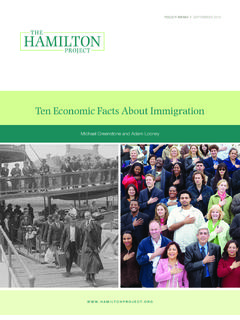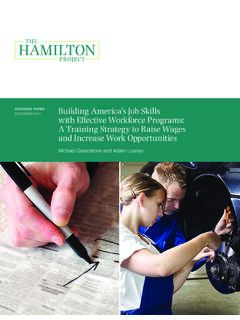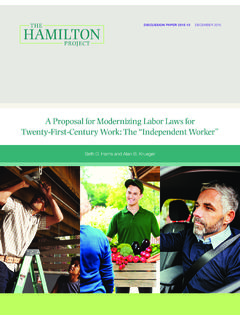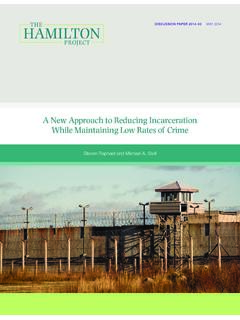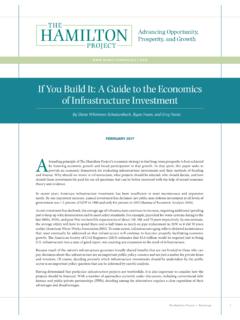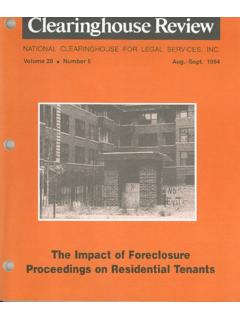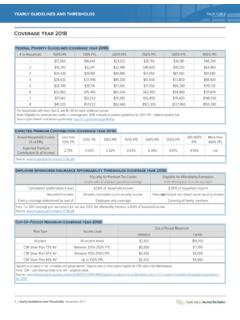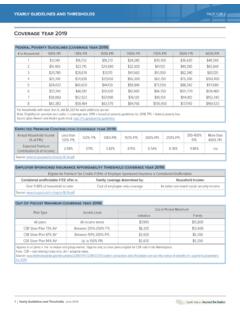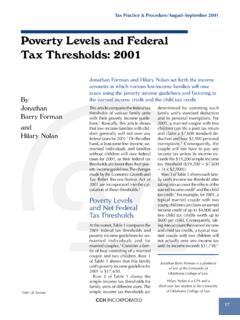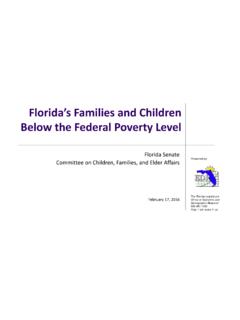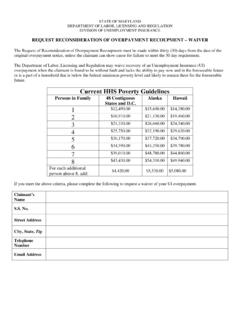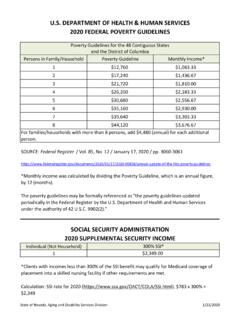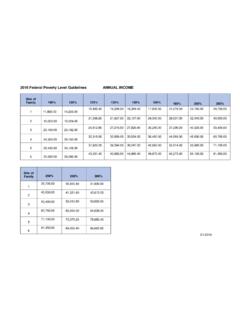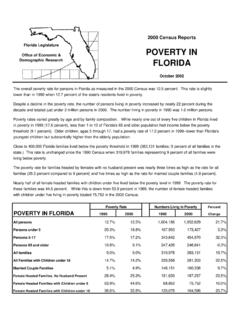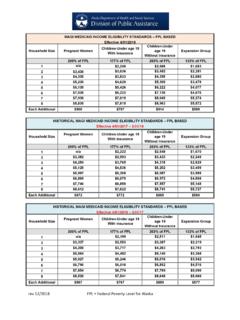Transcription of Policies to Address Poverty in America - Hamilton Project
1 JUNE 2014. Policies to Address Poverty in America Edited by Melissa S. Kearney and Benjamin H. Harris ACKNOWLEDGMENTS. The Hamilton Project wishes to thank members of its Advisory Council for their valuable insights and contributions to this book. In particular, the Project is grateful to Roger C. Altman, Robert Greenstein, Peter Orszag, Meeghan Prunty Edelstein, Robert E. Rubin, and Leslie B. Samuels for helpful discussions and comments on drafts. The contents of this volume and the individual papers do not necessarily represent the views of individual Advisory Council members. The policy memos contained in this volume have benefitted from the expert feedback provided by participants at The Hamilton Project anti- Poverty authors' conference held in March 2014 at the Brookings Institution.
2 We are very grateful to all who participated in that meeting. The editors acknowledge the outstanding work of The Hamilton Project staff on this volume. Karen Anderson provided expert guidance on all aspects of production, including providing feedback on multiple drafts of each of the individual papers. Elisa J come and Lucie Parker provided outstanding research assistance and steadfast dedication to the production of this volume. It would not have been possible without them. We also gratefully acknowledge the contributions of Joseph Sullivan, Chanel Dority, Laura Howell, Brian Goggin, Peggah Khorrami, and Allen Sirolly. And finally, we are grateful to David Dreyer, Susan Kellam, Alison Hope, and Fred Hviid. MISSION STATEMENT. The Hamilton Project seeks to advance America 's promise of opportunity, prosperity, and growth.
3 We believe that today's increasingly competitive global economy demands public policy ideas commensurate with the challenges of the 21st Century. The Project 's economic strategy reflects a judgment that long-term prosperity is best achieved by fostering economic growth and broad participation in that growth, by enhancing individual economic security, and by embracing a role for effective government in making needed public investments. Our strategy calls for combining public investment, a secure social safety net, and fiscal discipline. In that framework, the Project puts forward innovative proposals from leading economic thinkers based on credible evidence and experience, not ideology or doctrine to introduce new and effective policy options into the national debate.
4 The Project is named after Alexander Hamilton , the nation's first Treasury Secretary, who laid the foundation for the modern American economy. Hamilton stood for sound fiscal policy, believed that broad-based opportunity for advancement would drive American economic growth, and recognized that prudent aids and encouragements on the part of government are necessary to enhance and guide market forces. The guiding principles of the Project remain consistent with these views. Policies to Address Poverty in America EDITED BY: Melissa S. Kearney and Benjamin H. Harris JUNE 2014. 2 Policies to Address Poverty in America Table of Contents INTRODUCTION 5. SECTION 1. PROMOTING EARLY CHILDHOOD DEVELOPMENT. PROPOSAL 1. EXPANDING PRESCHOOL ACCESS FOR DISADVANTAGED CHILDREN 19.
5 PROPOSAL 2. ADDRESSING THE PARENTING DIVIDE TO PROMOTE EARLY. CHILDHOOD DEVELOPMENT FOR DISADVANTAGED CHILDREN 29. PROPOSAL 3. REDUCING UNINTENDED PREGNANCIES FOR LOW-INCOME WOMEN 37. SECTION 2. SUPPORTING DISADVANTAGED YOUTH. PROPOSAL 4. DESIGNING EFFECTIVE MENTORING PROGRAMS FOR DISADVANTAGED YOUTH 47. PROPOSAL 5. EXPANDING SUMMER EMPLOYMENT OPPORTUNITIES FOR LOW-INCOME YOUTH 55. PROPOSAL 6. ADDRESSING THE ACADEMIC BARRIERS TO HIGHER EDUCATION 67. SECTION 3. BUILDING SKILLS. PROPOSAL 7. EXPANDING APPRENTICESHIP OPPORTUNITIES IN THE UNITED STATES 79. PROPOSAL 8. IMPROVING EMPLOYMENT OUTCOMES FOR DISADVANTAGED STUDENTS 87. PROPOSAL 9. PROVIDING DISADVANTAGED WORKERS WITH SKILLS TO SUCCEED IN THE LABOR MARKET 97. SECTION 4. IMPROVING SAFETY NET AND WORK SUPPORT.
6 PROPOSAL 10. SUPPORTING LOW-INCOME WORKERS THROUGH REFUNDABLE CHILD-CARE CREDITS 109. PROPOSAL 11. BUILDING ON THE SUCCESS OF THE EARNED INCOME TAX CREDIT 119. PROPOSAL 12. ENCOURAGING WORK SHARING TO REDUCE UNEMPLOYMENT 129. PROPOSAL 13. DESIGNING THOUGHTFUL MINIMUM WAGE POLICY AT THE STATE AND LOCAL LEVELS 137. PROPOSAL 14. SMARTER, BETTER, FASTER: THE POTENTIAL FOR PREDICTIVE ANALYTICS. AND RAPID-CYCLE EVALUATION TO IMPROVE PROGRAM DEVELOPMENT AND OUTCOMES 147. AUTHORS 157. ENDNOTES 163. REFERENCES 171. The Hamilton Project Brookings 3. 4 Policies to Address Poverty in America Introduction Melissa S. Kearney, Benjamin H. Harris, and Karen L. Anderson The Hamilton Project WHY Poverty BELONGS ON THE NATIONAL POLICY Project work, percent of families live within 150 percent AGENDA of the Poverty line; nearly half live within 250 percent of the Millions of people live in Poverty in this country.
7 They threshold (Kearney et al. 2013). Many individuals and families suffer not only material deprivation, but also the hardships weave in and out of Poverty , even if they are not classified as and diminished life prospects that come with being poor. poor under the annual income measure. From 2009 to 2011, Childhood Poverty often means growing up without the about 90 million individuals percent of Americans . advantages of a stable home, high-quality schools, or were episodically poor (poor for two or more consecutive consistent nutrition. Adults in Poverty are often hampered months during a thirty-six-month period) (Edwards 2014). by inadequate skills and education, leading to limited wages In the aftermath of the Great Recession, some disadvantaged and job opportunities.
8 And the high costs of housing, health workers struggle to obtain the necessary training for care, and other necessities often mean that people must fruitful employment, while others grapple with long-term choose between basic needs, sometimes forgoing essentials unemployment at unprecedented rates. Long-term challenges like meals or medicine. While by some measures the poor remain with us: too many of our nation's youth drop out of suffer less material deprivation than their counterparts of a high school, too many of our children are born into unstable half century ago almost all households now have access to home environments, and too many of our young adults are basic necessities like electricity and running water, as well out of school and out of work.
9 This threatens our nation as consumer goods like televisions and computers the with the prospect of a permanent class of individuals who social and economic costs of Poverty remain as real as ever are unable to contribute productively to and benefit from a and threaten to undermine the nation's social fabric and thriving economy. economic future. Furthermore, research demonstrates that Poverty leads to Fifteen percent of Americans million adults and substantial and sustained neurobiological stressors that can million children lived in Poverty in 2012, according to the inhibit intellectual and emotional development and sound official Census Poverty This share rises to percent decision making. For children in particular, Poverty means when adjustments for costs and benefits are accounted living with the stress that comes from insufficient nutritional for under the more comprehensive Supplemental Poverty intake, living in the presence of violence in their community Measure (SPM).
10 Yet even these counts, as high as they are, or household, and not having a secure place to sleep at night. understate our nation's experience with Poverty . For every These challenges make it harder for children to learn and thrive person classified as poor, many more hover just above the in school, which, in turn, leads to problems that cumulate over threshold. As has been highlighted in earlier Hamilton childhood and into adulthood. The concern is that children The Hamilton Project Brookings 5. Introduction born into deprivation will live their lives stuck in a perpetual of Americans, they constitute percent of the episodically Poverty trap. poor and percent of the chronically poor (those who are poor for thirty-six consecutive months) (Edwards 2014).
